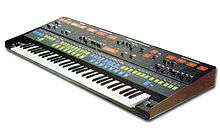ARP Quadra
| Quadra | |
|---|---|
 ARP Quadra | |
| Manufacturer | ARP Instruments, Inc. |
| Dates | 1978 - 1981 |
| Technical specifications | |
| Polyphony | 1 (Bass), 2 (Lead), All (String, Polysynth) |
| Timbrality | 4 |
| Oscillator | 4 (2/Lead, 1/Poly+String, 1/Bass) |
| LFO | Triangle, Square |
| Synthesis type | Analog Subtractive |
| Attenuator | Decay (Bass), AR (String), ADSR (Poly), ADSASR (Lead) |
| Storage memory | Panel Switch state, Octave, Osc. Interval |
| Effects | 1 (Stereo Phase Shifter) |
| Input/output | |
| Keyboard | 61-key synth-action with Channel Aftertouch (Lead only) |
| Left-hand control | Portamento VCO1, Portamento VCO2 |
| External control | CV/Gate |
The ARP Quadra was a 61 key analog musical synthesizer produced by ARP Instruments, Inc. from 1978 to 1981. The machine combined pre-existing products: the Omni, Odyssey, a Solina-esque string synthesizer unit, a phaser and a divide-down organ with ADSR envelope, and a 4075 24 db low pass filter into one box. It has four sections. Bass is on the bottom two octaves, has two unison bass circuits (electric and string), with AR and a single pole low pass filter and a related AD envelope for cutoff. A string section is similar to the ARP Omni. Poly Synth, and a two voice Lead Synth similar to the Odyssey and a five way mixer with four unit outputs, a stereo pair, a line mono and an XLR out.
There are 16 memory locations, but these do not provide storage of slider settings. The synthesizer's 8048-based microcontroller uses battery-backed CMOS SRAM storage[1] to store and recall 16 sets of on/off decisions about which waveforms and modulations are turned on in each of the four sections, and lead intervals. Using LEDs the player is visually directed to the sliders critical to the sound selected but their settings are not updated. This necessary tweaking and fine tuning is the weakness of the Quadra.
Like the Moog Polymoog keyboard, the Quadra was not a true polyphonic. It used divide-down circuits for the Omni-style string section, including ADSR, LFO, filter and VCAs for the Polyphonic Synth section. Both Polyphonic Synth and string sections share the hollow wave button which changes waveforms for both sections.
It has a simple arpeggiator for the lead section and memorizes intervals between the two lead VCOs. Vibrato, LFO and a fast square wave trill can be added to the arpeggiation. There are the two independent portamento rates for each VCO, whether locked together or in interval mode. This is useful in either multiple or single trigger mode.
Outstanding is the rich lush phase shifter which creates stereo and includes harmonic resonance. Also uncommon is the ability to deploy sample and hold within the phaser. The sound is similar to the chorus of the Solina, though many users avow that the Quadra, due to its sonic texture and modulation controls, is the richest string machine ever made.
The top three octaves of the keyboard have a mechanical touch sensor that can either pitch bend or impact brilliance and filter. Unique is the flat pedal feature which allows pedaling to dip individual notes and chords a semitone below so they rise to pitch with the envelope’s attack.
Extensive CV/Gate facilities allow two external sequencers to independently control both the bass and the lead. It is capable of four independent outs, stereo out, mono, and mono XLR but hidden in the quad outs is TRS facility for processing and returning effects on individual parts of the four sections to be recombined with external audio at a built-in mixer, which includes an internal compressor circuit. Like all ARP synthesizers of this series (2800) its true character opens up with selective use of the optional foot pedals.
The Quadra uses the typical ARP orange and black color scheme of the company's later years including the orange leather end pieces and the clean XLR out for DI console recording.
Notable users
Notable users of string synthesizers include:
- Joe Zawinul of Weather Report
- Tony Banks of Genesis
- Kerry Livgren of Kansas
- Paul Davis
- John Carpenter
- Rick Wright and David Gilmour of Pink Floyd
- Rayborn Huff of David and the Giants
- New Order
References
- ↑ "ARP Quadra Service Manual" (PDF). archive.org. Retrieved 2016-10-08.